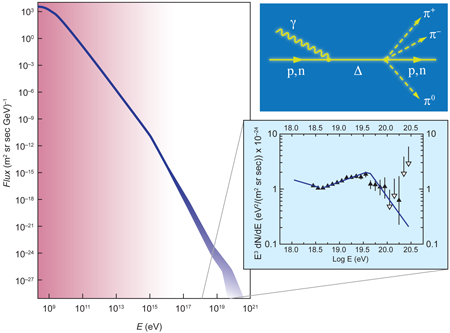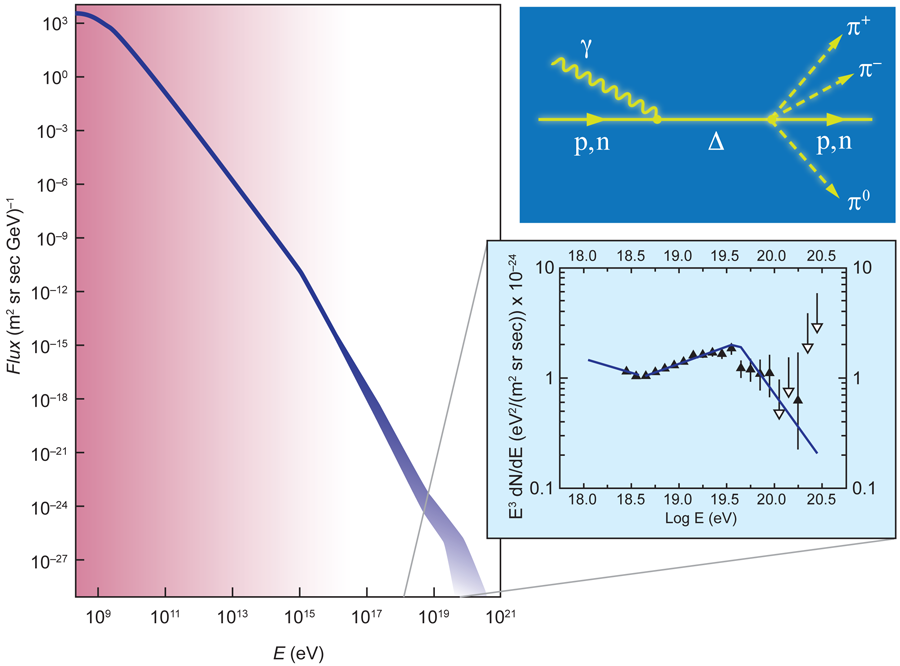An abrupt slowdown for particles on the fast track
Cosmic rays are high-energy particles—protons, nuclei, and electrons—accelerated by sources both within and outside the Galaxy. Over an enormous energy range, the flux of cosmic rays that strike the earth’s surface falls off with energy roughly according to a power law: with an energy-dependent spectral index . At 1 GeV, the intensity per unit solid angle per GeV is roughly 1000 particles per second over , but at energies near , the probability (per unit solid angle and per ) that a particle hits an area of is only about once per century!
The power-law spectral shape over most of the energy range (Fig. 1) suggests that similar processes are responsible for the acceleration [1]. Shocks in planetary magnetospheres, interplanetary space, and at the sun are believed to accelerate low-energy particles; shocks in expanding galactic supernova remnants are thought to be responsible for the particles up to approximately ; and shocks in the regions near active galactic nuclei (AGNs)—galaxies with highly luminous cores—may be responsible for accelerating the highest energy particles.
The energy spectrum of cosmic rays is not completely featureless though, and we can learn a great deal about the source and path these high-energy particles take on their trajectory to earth by analyzing the dips and kinks in the spectrum. For example, near , a “knee” occurs in the spectrum, presumably because this is the highest energy that particles can reach in galactic supernova remnants. In the region near – , additional structure in the spectrum has been thought for many years to be due to the propagation of the highest energy particles through intergalactic space. The Pierre Auger Observatory collaboration recently demonstrated that the arrival directions of cosmic rays above are correlated with the directions of nearby AGNs [2], clearly establishing the extragalactic origin of the highest energy particles. Now, two separate collaborations—the High Resolution Fly’s Eye (HiRes) and Auger—have published convincing evidence for the suppression of extragalactic particles at ultrahigh energies due to interactions with the cosmic microwave background [3,4]. This effect, named after the three physicists Greisen, Zatsepin, and Kuzmin (GZK) who predicted it 40 years ago [5], has only recently been measured with the advent of the very large, high-sensitivity cosmic-ray telescopes found at HiRes and Auger.
HiRes is an array of telescope modules designed to detect the ultraviolet fluorescence radiation emitted when incoming cosmic rays strike nitrogen nuclei in the atmosphere and produce extensive air showers. At , HiRes detects showers over an aperture of nearly sr at the Dugway Proving Ground in Utah. At the Auger Observatory in Malargüe, Argentina, the fluorescence technique is combined with an array of particle detectors spread out over the ground. Recently completed, the Auger array consists of four fluorescence telescopes and 1660 water Cerenkov detectors that cover . One advantage of the Auger approach compared to HiRes is that by viewing the same event using both the fluorescence and the surface air shower techniques, the experimenters can calibrate the energies determined using one technique against the other.
What causes the suppression in the cosmic-ray intensity near ? At an energy above , a cosmic-ray proton colliding with a photon in the microwave background can have a center of mass energy in excess of 1.08 GeV. This is sufficient energy to produce pions via photoproduction ( ) (Fig. 1, upper inset). The result is that at an energy near , protons can propagate no more than (1 megaparsec = ) from their source. If ultrahigh-energy protons from more distant sources are attenuated, then the high-energy spectrum must be suppressed. This was predicted by Greisen, Zatsepin, and Kuzmin in 1966 [5]. A pileup in the spectrum is also predicted near , and a dip in the spectrum near (known as the “ankle” in the spectrum) due to (electron-positron) pair production [6]. These predicted features have now been seen by HiRes [3] and, more recently, by Auger [4]. HiRes reports a steepening of the spectrum at and a dip at , consistent with the expected GZK cutoff and the dip due to pair production. The exponent of the differential power-law spectrum is measured to be below the ankle, between the ankle and the GZK cutoff, and above the GZK cutoff.
The Auger telescope, which has an exposure twice that of HiRes and four times that of the earlier AGASA (Akeno Giant Air Shower Array) experiment [7], measured a sample of 20,000 events above . The collaboration now reports a spectral index of 2.69 ± 0.02 (statistical error) ± 0.06 (systematic error) between and and an index above of (Fig. 1, lower inset). (It is noteworthy that the steepening in the spectrum occurs at the same energy at which the directional correspondence with AGNs appears). The HiRes and Auger results appear to be completely consistent.
Although the results appear to provide a strong confirmation of the predicted GZK cutoff, there are complications. First, the interpretation of the results depends on a model of the initial cosmic ray - air nucleus interaction. Yet the center of mass energy of a proton interacting with a target nucleon in the earth’s atmosphere is , well above the energies that can be reached at particle accelerators such as the Tevatron at Fermilab. The Large Hadron Collider (LHC) at CERN will provide hadronic interaction data up to 14 TeV, but extrapolations of the cross sections, multiplicities, rigidity distributions, and inelasticities of hadron collisions at high energies will still be necessary. At energies up to approximately , the energies and elemental composition of individual cosmic rays can be measured directly with experiments on high-altitude balloons and satellites. At higher energies, however, the particles are sufficiently rare that ground-based measurements must be made of the showers of secondary particles. These indirect measurements must rely heavily on Monte Carlo calculations for their interpretation. An essential component of these calculations is the hadronic interaction model. The SIBYLL and QGSJET models used by HiRes and Auger have been well tested at energies the Tevatron can reach but not the energies in the range of the GZK predictions. There is indeed evidence that the models are not completely correct when they are extended to high energy: the energies and composition derived from Auger surface array data are not completely consistent with those derived from the fluorescence data [8].
An additional point concerns the elemental composition of the incoming cosmic-ray beam. Direct measurements at energies below the knee show that the cosmic-ray beam is a mixture of accelerated particles covering the periodic table from hydrogen to uranium [9]. This implies that some of the interactions are nucleus-nucleus interactions rather than simple hadron-hadron interactions, further complicating the problem of properly modeling the interactions. At the very high air shower energies of HiRes and Auger, the primary means of determining elemental composition depends on measuring the depth of the shower’s maximum intensity in the atmosphere: An iron nucleus interacts earlier in the atmosphere and the shower reaches its maximum higher in the atmosphere than the shower produced by an incident proton of the same total energy, for example. The most recent Auger results based on this indirect measurement of the shower development rather than on a direct measurement of the incoming nucleus appear to show a composition that has a significant nuclear component [10], becoming slightly more proton-rich with increasing energy up to about the ankle in the spectrum at and then (depending on the interaction model) either staying constant or perhaps growing somewhat less proton-rich above .
The composition—protons or heavier nuclei—affects the shower development and the energies determined from the Monte Carlo calculations. It also affects the propagation of extragalactic particles. Heavy nuclei lose energy due to photodisintegration ( , where is a nucleon) and then (if the resulting nuclear fragment is unstable) decay [11]. Nuclei produced in extragalactic sources can be expected to photodisintegrate before they have propagated to earth. Recent calculations [12] suggest that extragalactic nuclei interacting with the microwave and infrared backgrounds will result in a flux of secondary protons that will then be suppressed by the GZK effect, and indeed with a proper choice of input assumptions, models of the sources and the propagation can be made to fit the measurements quite well. Thus, although the HiRes and Auger observations of the GZK cutoff are extremely convincing, the high-energy interaction models, the effects of a nuclear component in the cosmic-ray beam, the inputs to the propagation models, and of course the acceleration mechanisms and nature of the sources must be better understood before the question of the origin and propagation of the ultrahigh-energy cosmic rays can be considered completely solved.
References
- A. M. Hillas provides a comprehensive recent review of ultrahigh-energy cosmic rays in arXiv:astro-ph/0607109 (2006). He makes the point that the generally smooth cosmic-ray spectrum may hide a large number of contributions from different sources, acceleration processes, and propagation mechanisms merged together
- Pierre Auger Collaboration, Science 318, 938 (2007); J. Abraham et al., Astropart. Phys. 29, 188 (2008)
- R. U. Abbasi et al., Phys. Rev. Lett. 100, 101101 (2008)
- J. Abraham et al. (The Pierre Auger Collaboration), Phys. Rev. Lett. 101, 061101 (2008)
- K. Greisen, Phys. Rev. Lett. 16, 748 (1966); G. T. Zatsepin and V. A. Kuzmin, JETP Lett. 4, 78 (1966)
- C. T. Hill and D. N. Schramm, Phys. Rev. D 31, 564 (1985); V. S. Berezinsky and S. I. Grigorieva, Astron. Astrophys. 199, 1 (1988); An alternative explanation for the ankle, a transition from a galactic to an extragalactic origin, has been discussed by A. M. Hillas, Nucl. Phys. B Proc. Suppl. 136, 139 (2004); J. Phys. G: Nucl. Part. Phys. 31, R95 (2005)
- M. Takeda et al., Astroparticle Physics 19, 447 (2003)
- R. Engel for the Pierre Auger Collaboration, Proc. 30th Intl. Cosmic Ray Conf., Merida, arXiv:0706.1921v1 (2007)
- M. Shapiro and R Silberberg, Annu. Rev. Nucl. Sci. 20, 323 (1970); B. Wiebel-Sooth, P. L. Biermann, and H. Meyer, Astron. Astrophys. 330, 389 (1998)
- M. Unger for the Pierre Auger collaboration, Proc. 30th Intl. Cosmic Ray Conf., Merida arXiv:0706.1495 (2007)
- J. L. Puget, F. W. Stecker, and J. H. Bredekamp, Ap. J. 205, 538 (1976)
- R. Aloisio, V. Berezinsky, and A. Gazizov, arXiv:0803.2494v2 (2008)





